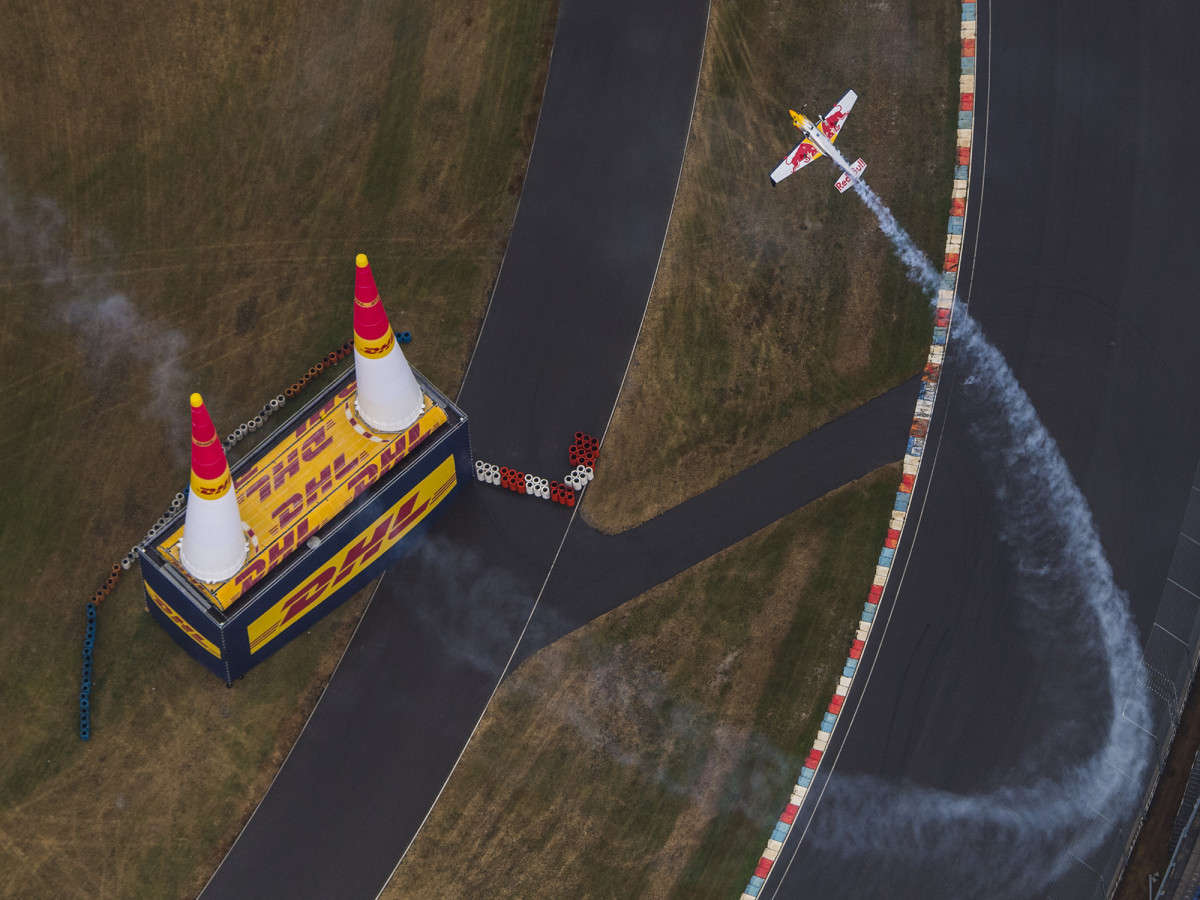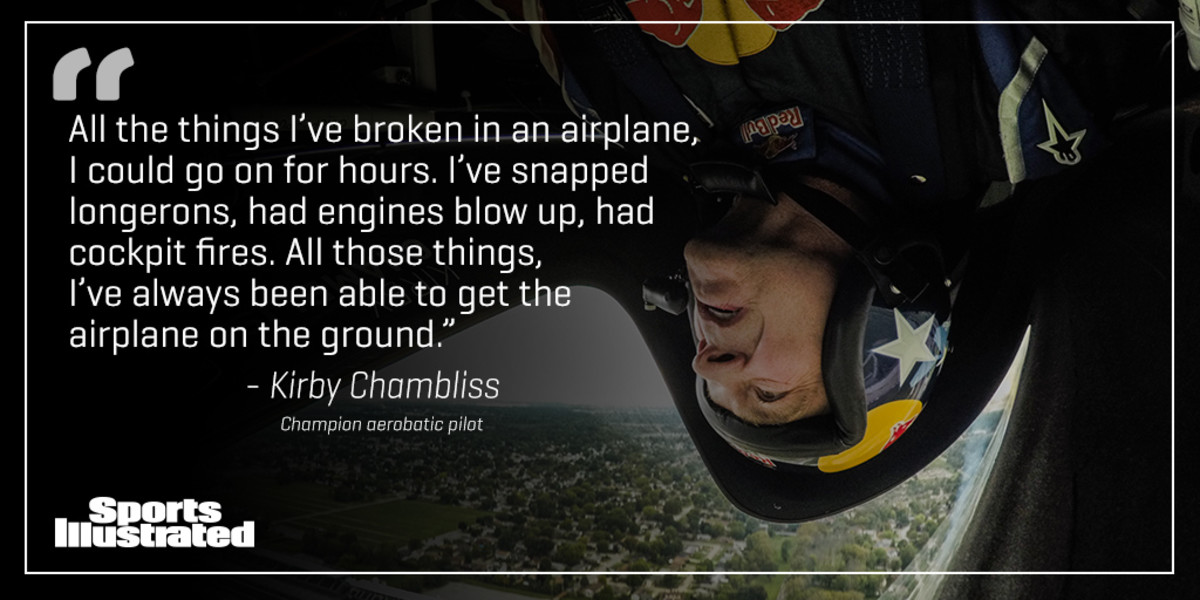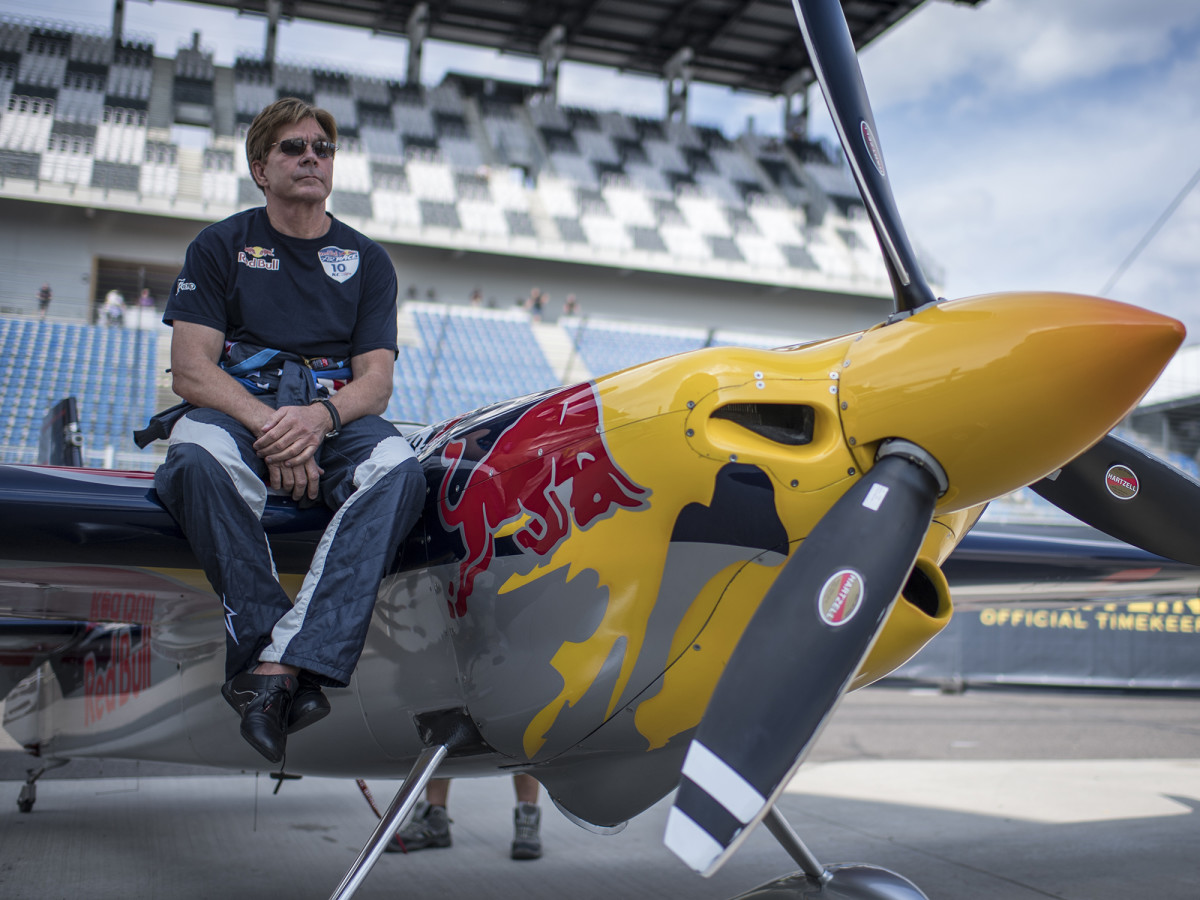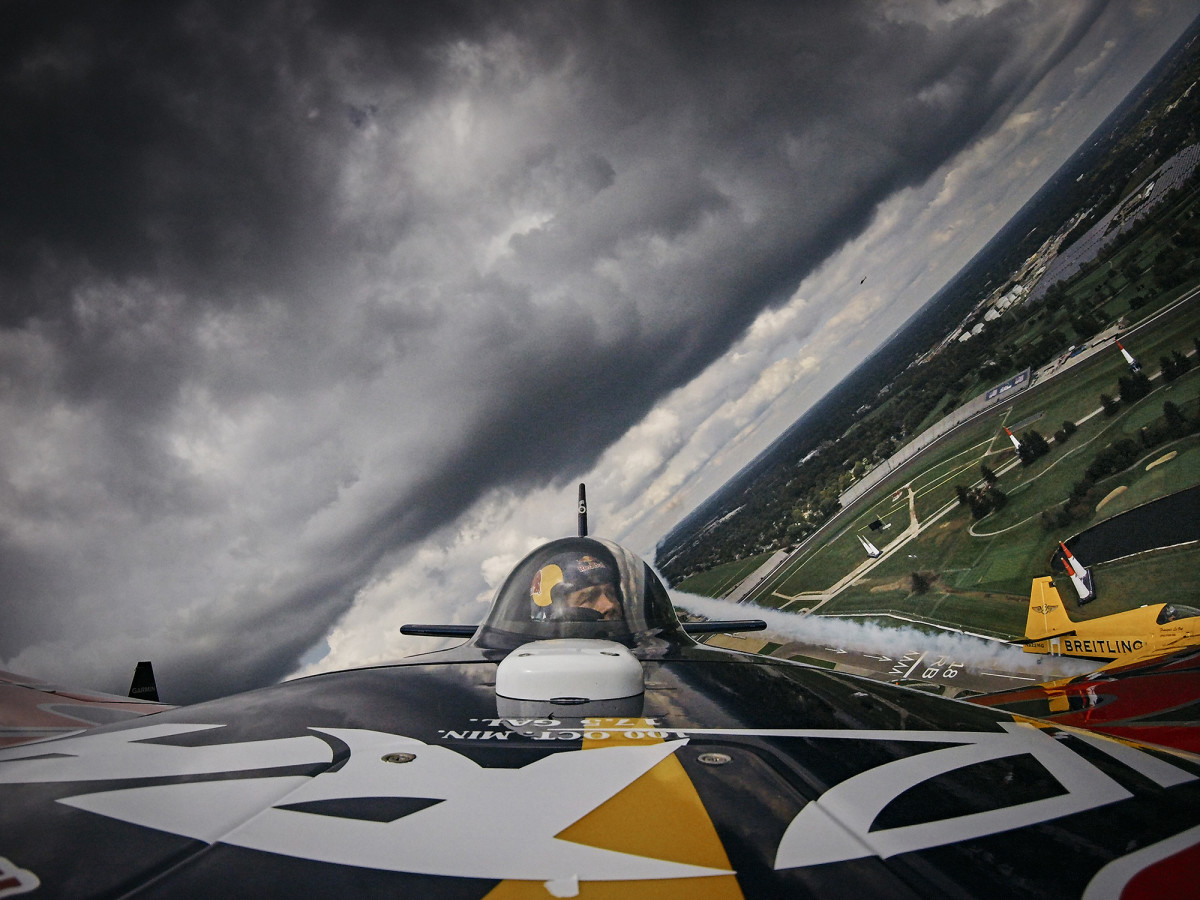Inside the head-spinning, upside-down world of aerobatic pilot Kirby Chambliss

Kirby Chambliss, one of the world’s best aerobatic pilots, remembers how the panic washed over him.
His daughter, Karly, is 11 now, and a fine aviatrix in her own right. When she was 18 months old, her dad was feeding her some watermelon. A piece lodged in her throat. He froze.
“I’m sure I would’ve done something eventually,” recalls Kirby, “but my wife, Kellie, who at the time was a flight attendant, grabbed her and, boom, boom—just like that she was all fixed up.”
Looking back on it, he admits, “I think I actually panicked. I just didn’t know what to do.”
“In the airplane,” says Chambliss, who will compete on October 15-16 in the final event of the Red Bull Air Race World Championship series in Las Vegas, “I know what to do.”
In a tight spot in El Salvador three years ago, he knew what to do. Preparing for an air shot, he’d just taken a low pass over the runway and gone into a high alpha—“the airplane is nose-up about 80 degrees, no speed at all, you’re hanging onto the propeller.” That’s when the engine “lost a governor,” he says, “and the prop just … stopped.”

Beyond the runway, the terrain dropped 250 feet into a ravine. “All I had time to do,” he recalls, “was stuff the nose over. I got the wing to fly again, and as soon as I got it loaded I had time to say ‘Oh s---,’ and think, ‘This is gonna hurt.’
“I put the left wing into a tree, the right wing into another one, the tail hit after that. So it was three smaller hits instead of one big one.”
He walked away from that one, unlike his 2001 crash in China. “I’d just gone under the bridge,” he recounts, casually, as if flying under a bridge is like making a right on red in a Dodge minivan. “I was in a bank of about 80 degrees, 15 degrees nose down, and was about to roll hard into the next maneuver.
“On the video,” he says, “you see the airplane roll hard, then just stop”—an aileron had jammed—“and then a fraction of a second later it hits the water.” The plane cartwheeled end-over-end “I don’t know how many times,” says Chambliss, who was pulled from the cockpit by rescue workers, and regained consciousness while being wheeled on a gurney through a nearby hospital.
Figuring out fatigue: A tired brain can hinder performance as much as a tired muscle
“There’s Chinese people all around me, I don’t recognize anyone, then I see Jean-Louis Monnet, one of the organizers. So I said, ‘Jean-Louis, what happened?’
“You crashed into the river,” the Frenchman replied.
“Well s---. That’s why I’m all wet!”
He suffered nothing more than a six-inch gash on his head. The impact peeled back his skin, making him look, before the stitches, half-scalped.
People tell me, ‘You’re really lucky,’ and I say, ‘Nah, I’m sort of lucky. Really lucky, it wouldn’t have happened,’” he says. “All the things I’ve broken in an airplane, I could go on for hours. I’ve snapped longerons, broken the stick off, had engines blow up, seize up. I’ve had cockpit fires. All those things, I’ve always been able to get the airplane on the ground.”
He is too wise, too experienced, to share stories of jammed ailerons and snapped joysticks in the minutes before taking me up in his Zivco Edge 540t two-seater last spring. He shared them after ragdolling my middle-aged ass all over the desert sky; after a series of snap rolls, barrel rolls, spins, stalls, tail-slides, corkscrews, cartwheels and various other maneuvers which thrilled and terrified me but also, because I was unaccustomed to pulling five or six Gs, made me this close to losing my breakfast.

“That’s your puke bag,” Team Chambliss member Stan Gray had told me, after strapping me into the front seat of the plane. “Basically, it’s just a big Ziploc.”
Moments earlier, I’d emerged from a changing room adjoining the immaculate hangar at Chambliss’s Flying Crown Ranch, between Phoenix and Tucson. They’d given me a Red Bull jumpsuit to put on. “That’s a good looking flight suit!” Stan remarked, and even though he said it with a straight face I’m fairly certain I was being ridiculed.
He got me set up with my parachute, then issued instructions on where not to put my feet and hands. “This is for the ailerons,” he said, motioning to a rod at chest-level in front of me, “so don’t hold it where it says DON’T HOLD.” He told me not to worry if the cockpit filled with smoke:
“When you’re flying around, doing flat spins and different kinds of maneuvers, a lot of smoke will come into the cabin here. Don’t worry about it—you’re not on fire.”
Athletes can now track hemoglobin and pulse rate levels without getting bloodwork
He handed me my headgear, an unfortunate, off-white skullcap designed, it seemed, to strip me of any aviator’s panache, and make me feel like the spermatozoon played by Woody Allen in Everything You Always Wanted To Know About Sex.
And then Kirby climbed in. About one and a half seconds after takeoff he flipped us upside-down, chatting all the while as if we were sitting in a Starbucks. The next 12 minutes made me physically ill, it’s true, but also gave me a deeper understanding of a poem I’d already admired, John Gillespie Magee, Jr.’s “High Flight”:
Oh! I have slipped the surly bonds of Earth
And danced the skies on laughter-silvered wings;
Sunward I've climbed, and joined the tumbling mirth
Of sun-split clouds—and done a hundred things
You have not dreamed of…
Back in the clutches of those surly bonds, I stretched out on the floor of the hangar, waiting for the nausea to pass. Chambliss stood over me at one point, explaining, in part, what had just happened:
“When we did the snaps, we were pulling stick back, and we were stalling the wing positive, that’s an inside snap.” From my supine position, I nodded, thinking, What the hell does he mean, “we?” “Outside snap is when the stick goes forward, and the airfoil stalls to the outside, and you can be right-side up and do it, or upside-down, and go straight up! It’s really cool, but negative Gs are a little bit harder on you. Sometimes you bust a few capillaries in your eyes.”
I told him he was smart to put the plane down when he did. “I could tell your enthusiasm was starting to flag there,” he replied. “But wasn’t that cool going 200 mph upside-down over the cactus and through that rock formation?
“In an hour or so you’re going to feel just fine, and you’ll always remember doing this.”
Before long he was back in his plane, back in his happy place, upside-down in the sky.
After recovering enough to sit up against the wall, I met Kellie Chambliss, who’d emerged from her office.

“Kirby and I met when he hired me to decorate his house,” she recalls. At the time, she was a Southwest flight attendant who did some interior decorating on the side. “In my early days, I liked to do fun things—scuba dive, jump fences on horses.” She appreciated a good adrenaline buzz, as did, she discovered, her new client. They began dating, and married in 1993.
Kellie, too, became a pilot, and took a job flying skydivers to the jump zone. Both love the rush of jumping from airplanes, but Kellie has “dialed it back quite a bit” since Karly was born in 2005. Not everyone in the family can be a daredevil.
Kirby, for his part, can’t be enough of one. When he told his wife he wanted to take up BASE-jumping, she was not pleased, asking, “How many ways do you want to try to kill yourself?”
After her husband’s unscheduled dip in China’s Songhua River in ’01, Kellie asked him to consider retiring from aerobatic flying. “His response was, ‘Kellie, I don’t even remember it.’”
In other words: No. “He is who he is,” she concludes. He always has been.
Born in Corpus Cristi, Kirby was the son of a skydiving jumpmaster named Max Chambliss. “He would throw students out,” Kirby explains, “then jump out after them.” Even as a small boy, with his parents divorced and babysitters hard to come by, Kirby would accompany his father to the airport most mornings, and go up with him. Unlike his dad, he’d stay in the plane. “I’d be freezing my ass off,” he says, “’cause the door was usually off, and I was in my pajamas. But that’s where I got interested in flying.”
When he was 13, he helped his old man build an airplane.
“And when I say helped, I mean he’d say, ‘Get your ass home, you’re gonna buck the rivets in the fuselage.’ So that’s what I did,” Chambliss says.
The provenance of that plane is a short story unto itself: One day, Max arrived at home with a set of plans and a U-Haul trailer full of sheet metal. He intended to build his own airplane. It wasn’t like one of today’s do-it-yourself, pre-drilled kits, Kirby notes. “It was just a set of plans, and a bunch of sheet metal.”
NBA trainer Joe Abunassar is also a longtime triathlete headed to Ironman Kona
A year later, Max flew it.
By then, Kirby knew he wanted to fly airplanes. He worked at a nearby airport as a “line boy,” refueling small planes, moving them around. After moving to Phoenix, he worked for Southwest, refueling their jets, then “throwing bags”—luggage handling—then as a ramp agent. While working in operations for Southwest, he started his flight training, then became a flight instructor at a different company. After a brief stint flying night freight, he was hired to fly a private jet, ferrying around the top brass of La Quinta Motor Inns. Less than three years later, he returned to Southwest as a commercial pilot. He was 24.
It was during his time with La Quinta that the chief pilot told Chambliss, “If this jet ever goes upside-down with the CEO on board, we want you to be able to turn it right-side up.” In 1985 they sent him to aerobatic training. An epiphany awaited.

“I went out with the aerobatic instructor, we turned it upside-down and I just thought, Wow, this is the coolest thing ever,” he recounts. “After that, I couldn’t have cared less about flying straight and level. All I wanted to do was fly aerobatics.” He worked for the airlines to support his new habit.
By 1997, he was captain of the U.S. Aerobatic team. Chambliss has won five national championships and 13 medals at the world championships. Going into this weekend’s event at the Las Vegas Motor Speedway, Chambliss stands in ninth place in the Red Bull Air Race World Championship standings. In this format, pilots navigate an aerial racetrack featuring air-filled pylons in the fastest possible time. It’s thrilling. It’s jaw dropping. For a pilot of Chambliss’s virtuosity, it’s also a bit limiting. When he’s not competing for Red Bull, he enjoys performing at traditional air shows, where he’s able to display the full range of his talents.
His goal at a race is to win—duh—whereas his goal at an airshow is to “paint that perfect picture in the sky, to have everybody go, ‘Wow—I’ve never seen a plane do that before!’”
He is an artist, the airplane his instrument. To take it away would be to remove his reason for being. Kellie gets that. She’s comforted by the knowledge that, regardless of what it may look like when her husband is tumbling end-over-end out of the sky, “he’s very calculating in the risks he takes. He’s not a seat-of-the-pants guy.
“So many times, he could’ve died, but his ability to concentrate, even in the most dire circumstances, and work out the problem and fly the plane to the ground, has saved his life”—a life that would be hollowed out, devoid of color and meaning, if they made him fly straight and level.
